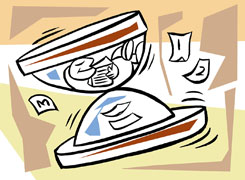Hi
I am an it professional.
My annual ctc is 45 lacs. I have 26 lacs in epf, 24 lacs in equity, 1.1 lacs in gold soverign bond. I own a car and scooty. I have one flat in greater noida with 30 lacs as loan . My monthly expense is 70k.
I also have paternal property worth 3cr which is in village from where currently i am getting nothing.
My wife is home maker and i have 2 children(girl 9 years old, boy 4 years old)
I want to retire after 5 years . How should i plan my investment
Ans: You have a diverse financial portfolio, which includes a high annual income, investments in EPF, equity, gold bonds, a car, a scooty, and a flat with a loan. Your monthly expenses are Rs. 70,000, and you also own a valuable paternal property. Your goal is to retire in 5 years. Let's discuss how you can plan your investments to achieve a secure retirement.
Evaluating Current Investments
1. Employee Provident Fund (EPF):
Your EPF balance of Rs. 26 lakhs is a stable and secure investment. It provides assured returns and tax benefits. Continue contributing to your EPF to build a strong retirement corpus. It will be a significant part of your retirement income.
2. Equity Investments:
Your Rs. 24 lakhs in equity indicate a good start towards wealth creation. Equity investments have the potential for high returns, especially over the long term. However, they come with market risks. To mitigate this, diversify your equity portfolio across various sectors and companies. Regularly review and rebalance your portfolio with the help of a Certified Financial Planner.
3. Gold Sovereign Bonds:
You have Rs. 1.1 lakhs in gold sovereign bonds, which provide security and act as a hedge against inflation. It's good to have some exposure to gold, but don’t rely solely on it. Continue holding these bonds as part of your diversified portfolio.
4. Real Estate:
Your flat in Greater Noida, with a loan of Rs. 30 lakhs, is both an asset and a liability. Real estate can provide stability and potential appreciation, but it also ties up capital. Focus on paying off the loan efficiently to reduce interest burden and enhance equity in the property.
5. Paternal Property:
Your paternal property worth Rs. 3 crores is a significant asset. Although it currently generates no income, it has potential for future returns. Consider ways to monetize this property, such as leasing it out or developing it, to create an additional income stream.
Assessing Monthly Expenses
Your monthly expense of Rs. 70,000 includes household expenses, children's education, and lifestyle costs. As you plan for retirement, it's crucial to ensure that your post-retirement income can cover these expenses comfortably. Factoring in inflation is essential to maintain your standard of living.
Investment Planning for Retirement
1. Mutual Funds:
Mutual funds are excellent for long-term wealth creation. They offer diversification, professional management, and potential for high returns. Here’s how you can approach mutual fund investments:
a. Equity Mutual Funds:
Allocate a significant portion of your investments to equity mutual funds. These funds invest in stocks and have the potential for high returns. They are suitable for your moderate to high-risk appetite. Choose funds with a strong track record and diversify across large-cap, mid-cap, and small-cap funds.
b. Debt Mutual Funds:
Include debt mutual funds for stability and regular income. These funds invest in fixed-income securities and are less volatile than equity funds. They provide liquidity and help balance the risk in your portfolio. Opt for short-term and medium-term debt funds for better returns than traditional fixed deposits.
c. Hybrid Mutual Funds:
Hybrid funds offer a mix of equity and debt investments. They provide a balanced approach, combining growth potential and stability. These funds are suitable for investors nearing retirement, offering both capital appreciation and regular income.
Advantages of Mutual Funds:
Diversification: Mutual funds invest in a wide range of securities, reducing risk.
Professional Management: Fund managers have expertise in selecting and managing investments.
Liquidity: You can easily buy and sell mutual fund units, providing flexibility.
Power of Compounding: Reinvesting returns can significantly grow your investment over time.
2. Systematic Investment Plan (SIP):
SIPs allow you to invest a fixed amount regularly in mutual funds. This disciplined approach helps in averaging the cost of investment and reduces market timing risks. Start a SIP with a comfortable amount and gradually increase it as your income grows. SIPs are ideal for building a substantial corpus over the long term.
3. Child Education Fund:
Plan for your children's higher education expenses. Create a dedicated education fund using a mix of equity and debt investments. This fund should grow over time to meet the future costs of education, ensuring your children have the best opportunities without financial stress.
4. Emergency Fund:
Maintain an emergency fund equivalent to 6-12 months of expenses. This fund provides a safety net for unexpected financial challenges, such as medical emergencies or job loss. Keep this fund in a liquid and easily accessible form, like a savings account or liquid mutual funds.
5. Life Insurance:
Ensure adequate life insurance coverage to protect your family in case of an unfortunate event. Term insurance is the most cost-effective option, providing a high sum assured at a low premium. Review your existing policies and enhance coverage if needed.
6. Health Insurance:
Having comprehensive health insurance is crucial to cover medical expenses without dipping into your savings. Opt for a family floater plan that covers your entire family. Review the coverage and enhance it if necessary, considering the rising healthcare costs.
7. Retirement Corpus Calculation:
Estimate the retirement corpus required to sustain your lifestyle post-retirement. Consider factors like inflation, life expectancy, and desired monthly income. A Certified Financial Planner can help you with accurate calculations and create a personalized retirement plan.
8. Reducing Debt:
Focus on reducing and eventually eliminating your home loan. This will free up your finances and reduce the interest burden. Prioritize debt repayment along with your investment goals.
9. Estate Planning:
Plan for the distribution of your assets to ensure your family's financial security. Create a will to specify how your assets should be distributed among your heirs. Consider setting up trusts if needed for managing and protecting your wealth.
Final Insights
Retirement planning requires a comprehensive and strategic approach. By diversifying your investments, reducing debt, and ensuring adequate insurance coverage, you can build a secure financial future. Here’s a summary of the key steps to take:
Continue contributing to your EPF for assured returns and tax benefits.
Diversify your equity investments to manage risk and maximize returns.
Hold on to your gold sovereign bonds as a hedge against inflation.
Pay off your home loan efficiently to reduce interest burden.
Explore ways to monetize your paternal property for additional income.
Invest in mutual funds, with a mix of equity, debt, and hybrid funds.
Start and increase SIPs for disciplined and regular investments.
Create a dedicated education fund for your children's future.
Maintain an emergency fund for unexpected financial challenges.
Ensure adequate life and health insurance coverage.
Estimate your retirement corpus and plan accordingly.
Focus on reducing and eliminating debt.
Plan your estate to secure your family's financial future.
By following these steps and regularly reviewing your financial plan with a Certified Financial Planner, you can achieve a comfortable and financially secure retirement. Your diverse portfolio and proactive approach will help you build a strong foundation for the future.
Best Regards,
K. Ramalingam, MBA, CFP,
Chief Financial Planner,
www.holisticinvestment.in













.jpg)















